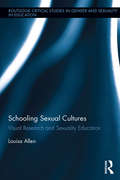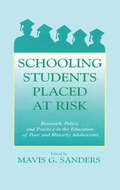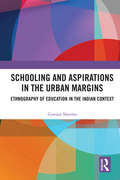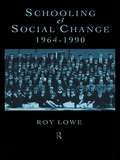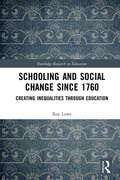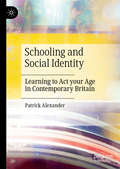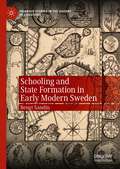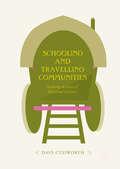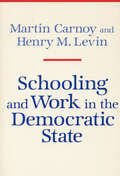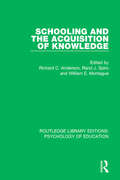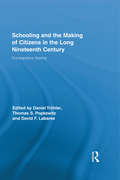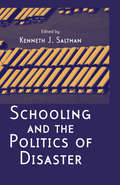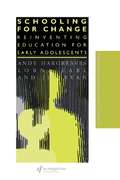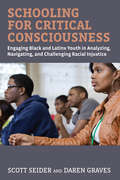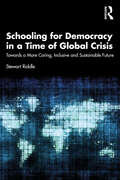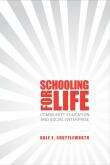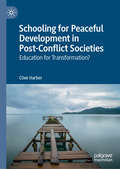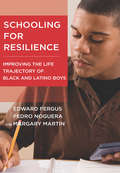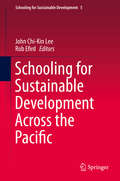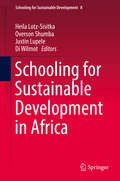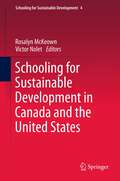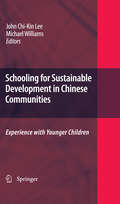- Table View
- List View
Schooling Sexual Cultures: Visual Research in Sexuality Education (Routledge Critical Studies in Gender and Sexuality in Education)
by Louisa AllenMoving beyond the traditional focus on curriculum and pedagogy, this volume explores hidden dimensions of sexuality education in schools and how sexual meanings are produced. Challenging the standard understandings of sexuality education, Allen discusses how students’ knowledge of sexualities is often learnt outside the ‘official’ school curriculum in informal spaces such as the sports field, gym locker rooms and peer groups. By employing visual methods and analysing student photo-diaries, Allen’s original book captures a sexual culture of schooling that allow readers to literally ‘see through young people’s eyes.’ Introducing theoretical ideas in relation to queer theory and ‘new’ feminist new materialisms, this volume calls for a re-conceptualization of how sexuality comes into being at school, in order to take account of its material, spatial and embodied elements.
Schooling Students Placed at Risk: Research, Policy, and Practice in the Education of Poor and Minority Adolescents
by Mavis G. SandersThis book examines historical approaches and current research and practice related to the education of adolescents placed at risk of school failure as a result of social and economic conditions. One major goal is to expand the intellectual exchange among researchers, policymakers, practitioners, and concerned citizens on factors influencing the achievement of poor and minority youth, specifically students in middle and high schools. Another is to encourage increased dialogue about policies and practices that can make a difference in educational opportunities and outcomes for these students. Although the chapters in this volume are not exhaustive, they represent an array of theoretical and methodological approaches that provide readers with new and diverse ways to think about issues of educational equality and opportunity in the United States. A premise that runs through each chapter is that school success is possible for poor and minority adolescents if adequate support from the school, family, and community is available. *The conceptual approach (Section I) places the research and practice on students placed at risk in a historical context and sets the stage for an important reframing of current definitions, research, policies, and practices aimed at this population. *Multiple research methodologies (Sections II and III) allow for comparisons across racial and ethnic groups as well as within groups, and contribute to different and complementary insights. Section III, "Focus on African-American Students," specifically addresses gender and social class differences among African-American adolescents. *Current reform strategies presently being implemented in schools throughout the United States are presented and discussed (Part IV). These strategies or programs highlight how schools, families, and communities can apply research findings like the ones this book presents, thus bridging the often wide gap between social science research and educational practice.
Schooling and Aspirations in the Urban Margins: Ethnography of Education in the Indian Context
by Gunjan SharmaThis book presents a detailed ethnographic study conducted in an urban slum in India. It explores how a State school, as a social and pedagogic institution, shapes the aspirations and worldviews of children in the urban margins. The volume engages with the children's experience of marginality and exclusion as they negotiate the intersecting axes of caste, class, gender, and citizenship. It further explores how their everyday school experience is mediated by the power asymmetries between the teachers and the community. In this process, it makes-sense of the political dynamics between the State and its margins while highlighting the role of schools and locating childhood in this context. Based on ethnographic fieldwork, the book will be of interest to researchers, students, and teachers of education studies, sociology and politics of education, teacher education, childhood and youth studies, and urban studies. It will also be useful for education policymakers, and professionals in the development sector.
Schooling and Equality: Fact, Concept and Policy
by Dave Hill Mike ColeThis text covers the range of equality issues in school level education from the perspective and needs of educators, trainee teachers and students of education. It uses a blend of issues, concepts, facts and research to open up key issues and consider policy developments in the field.
Schooling and Social Change 1964-1990
by Roy LoweThis is the first book to offer an overview of the ways in which the sweeping social and economic changes of the modern period have impacted on the education system. Roy Lowe draws on estensive research to paint a vivid picture of the ways in which schools and universities were moulded by external events and of the part they played in promoting modernisation of society.The book explores some key themes:* the nature of the economic transformations taking place;* the growing awareness of gender issues;* the changing ethnic composition of modern Britain;* the bureaucratisation of society and the rise of a new politics.Exploring the links between these issues and educational provision, Lowe argues that the growing political significance of educational issues is largely explained by the critical part played by the education system in providing social and economic stability during these years of swift social change.Roy Lowe is Professor of Education at the University of Wales, Swansea.
Schooling and Social Change Since 1760: Creating Inequalities through Education (Routledge Research in Education)
by Roy LoweSchooling and Social Change in England since 1760 offers a powerful critique of the situation of British education today and shows the historical processes that have helped generate the crisis confronting policymakers and practitioners at the present time. The book identifies the key phases of economic and social change since 1760 and shows how the education system has played a central role in embedding, sustaining and deepening social distinctions in Britain. Covering the whole period since the first industrialization, it gives a detailed account of the development of a deeply divided education system that leads to quite separate lifestyles for those from differing backgrounds. The book develops arguments of inequalities through a much-needed account of the changes in education. This book will be of great interest for academics, scholars and post-graduate students in the field of history of education and education politics. It will also appeal to administrators, teachers and policy makers, especially those interested in the historical development of schooling.
Schooling and Social Identity: Learning to Act your Age in Contemporary Britain
by Patrick AlexanderThis book examines the nature of age as an aspect of social identity and its relationship to experiences of formal education. Providing a new and critical approach to debates about age and social identity, the author explores why age remains such an important aspect of self-making in contemporary society. Through an ethnographic account of a secondary school in the south-east of England, the author poses three principal questions. Why are schools in English organised according to age? How do pupils and teachers learn to ‘act their age’ while at school? Ultimately, why does age remain such an important and complex organising concept for modern society? Cutting across lines of class and gender, this timely book will be of interest to students and scholars of self-making and identity in educational contexts, and others interested in how schooling socialises young people into categories of age as the foundational building blocks of modern society.
Schooling and State Formation in Early Modern Sweden (Palgrave Studies in the History of Childhood)
by Bengt SandinIn this book the emergence of schools in urban Sweden between the seventeenth and the nineteenth century provides the framework for a history of children and of childhood. It is a study through the lens of the changes in early modern education, spatial aspect of the life of children and systems of governance in the early modern Swedish state. Educational systems defined the spatial aspects of childhood—where children were supposed to grow up, in the home, the school, the streets and alleys, or the place of work—over a period of about two hundred years. Schools and education represent both a mental and a physical space; an abstract place for children as well as a local and concrete place for them, which stood out against the alternative spatial aspects of the life of children. It is also a study of how different cultural systems influence the definitions of childhood and schools, in the context of church and home instruction, poor relief, policing, surveillance, and the question of why children went to schools. It examines the role of the school as childcare and as a provider of food, shelter and welfare, and as governance.
Schooling and Travelling Communities: Exploring the Spaces of Educational Exclusion
by Dave CudworthThis book calls for a re-thinking of educational provision for Gypsy / Traveller communities. Despite having been recognised by the government and educational providers for over fifty years, underachievement of children from Gypsy / Traveller communities persists. Rather than focusing specifically on access, attendance and attainment, the author provides a structural analysis of the cultural tensions that often exist between Nomadic communities and current school provision based on the interests and values of Sedentarism. The author uses spatial theory as a base upon which to build knowledge and understanding of the educational exclusion of children from Gypsy / Traveller communities, highlighting the social role that space plays within schools. This innovative book will be of interest and value for students and scholars interested in not only education and Gypsy / Traveller communities, but education for minority communities more widely.
Schooling and Work in the Democratic State
by Martin Carnoy Henry LevinA new explanation of the relation between schooling and work in the democratic, advanced industrial state emerges from this study that rejects both traditional views and the more recent Marxian perspective. Traditional views consider schools as autonomous institutions that are able to pursue the goals of equality and social mobility irrespective of the inequalities of capitalist society; the Marxian perspective views schools as serving the role of producing wage-labor for capitalistic exploitation. The authors suggest that the shortcomings of both views are rooted in the fact that they do not recognize the true functions of the democratic, capitalist state. The state is seen as an arena for struggle between forces pushing for egalitarian, democratic reforms and those seeking to use the resources of the state for private capital accumulation. Depending on which side has primacy at the moment, schools will reflect one set of goals over the other. However, victory is never complete, and the tide of battle has shifted back and forth historically. The authors develop this theory through interpreting the dynamic relation between U.S. schools and the workplace. Based on this approach, they predict changes in both schooling and work as well as the forms that future conflicts between the contending forces are likely to take.
Schooling and the Acquisition of Knowledge (Routledge Library Editions: Psychology of Education)
by RICHARD C. ANDERSON, RAND J. SPIRO AND WILLIAM E. MONTAGUEOriginally published in 1977, this book reports the proceedings of a conference sponsored by the Navy Personnel Research and Development Center. The one common thread running through all of the formal papers and dialogue was that the knowledge a person already possesses is the principal determiner of what that individual can learn from an educational experience. These questions were addressed: How is knowledge organized? How does knowledge develop? How is knowledge retrieved and used? What instructional techniques promise to facilitate the acquisition of new knowledge? The kinds of answers provided are characterized by their as well as by their specificity. Accordingly, the volume should be of interest to both the generalist and the specialist.
Schooling and the Making of Citizens in the Long Nineteenth Century: Comparative Visions (Routledge Research in Education)
by David F. Labaree Thomas S. Popkewitz Daniel TröhlerThis book is a comparative history that explores the social, cultural, and political formation of the modern nation through the construction of public schooling. It asks how modern school systems arose in a variety of different republics and non-republics across four continents during the period from the late eighteenth century to the early twentieth century. The authors begin with the republican preoccupation with civic virtue – the need to overcome self-interest in order to take up the common interest – which requires a form of education that can produce individuals who are capable of self-guided rational action for the public good. They then ask how these educational preoccupations led to the emergence of modern school systems in a disparate array of national contexts, even those that were not republican. By examining historical changes in republicanism across time and space, the authors explore central epistemologies that connect the modern individual to community and citizenship through the medium of schooling. Ideas of the individual were reformulated in the nineteenth century in reaction to new ideas about justice, social order, and progress, and the organization and pedagogy of the school turned these changes into a way to transform the self into the citizen.
Schooling and the Politics of Disaster: Taking And Breaking Public Schools (Cultural Politics And The Promise Of Democracy Ser.)
by Kenneth J. SaltmanSchooling and the Politics of Disaster is the first volume to address how disaster is being used for a radical social and economic reengineering of education. From the natural disasters of the Asian tsunami and the hurricanes in the Gulf Coast, to the human-made disasters in Iraq, Afghanistan, Haiti, Sudan, Indonesia, the United States and around the globe, disaster is increasingly shaping policy and politics. This groundbreaking collection explores how education policy is being reshaped by disaster politics. Noted scholars in education and sociology tackle issues as far-ranging as No Child Left Behind, the War on Terror, Hurricane Katrina, the making of educational funding crises in the US, and the Iraq War to bring to light a disturbing new phenonmemon in educational policy.
Schooling as Violence: How Schools Harm Pupils and Societies
by Clive HarberAsking fundamental and often uncomfortable questions about the nature and purposes of formal education, this book explores the three main ways of looking at the relationship between formal education, individuals and society: * that education improves society* that education reproduces society exactly as it is* that education makes society worse and harms individuals. Whilst educational policy documents and much academic writing and research stresses the first function and occasionally make reference to the second, the third is largely played down or ignored. In this unique and thought-provoking book, Clive Harber argues that while schooling can play a positive role, violence towards children originating in the schools system itself is common, systematic and widespread internationally and that schools play a significant role in encouraging violence in wider society. Topics covered include physical punishment, learning to hate others, sexual abuse, stress and anxiety, and the militarization of school. The book both provides detailed evidence of such forms of violence and sets out an analysis of schooling that explains why they occur. In contrast, the final chapter explores existing alternative forms of education which are aimed at the development of democracy and peace. This book should be read by anyone involved in education - from students and academics to policy-makers and practitioners around the world.
Schooling for Change: Reinventing Education for Early Adolescents (Teachers' Library)
by Andy Hargreaves Lorna Earl Jim RyanFocusing on change and reform in secondary and elementary schools, this book explores the possibilities for better schooling for early adolescents.
Schooling for Critical Consciousness: Engaging Black and Latinx Youth in Analyzing, Navigating, and Challenging Racial Injustice
by Scott Seider Daren GravesSchooling for Critical Consciousness addresses how schools can help Black and Latinx youth resist the negative effects of racial injustice and challenge its root causes. Scott Seider and Daren Graves draw on a four-year longitudinal study examining how five different mission-driven urban high schools foster critical consciousness among their students. The book presents vivid portraits of the schools as they implement various programs and practices, and traces the impact of these approaches on the students themselves. The authors make a unique contribution to the existing scholarship on critical consciousness and culturally responsive teaching by comparing the roles of different schooling models in fostering various dimensions of critical consciousness and identifying specific programming and practices that contributed to this work. Through their research with more than 300 hundred students of color, Seider and Graves aim to help educators strengthen their capacity to support young people in learning to analyze, navigate, and challenge racial injustice.Schooling for Critical Consciousness provides school leaders and educators with specific programming and practices they can incorporate into their own school contexts to support the critical consciousness development of the youth they serve.
Schooling for Democracy in a Time of Global Crisis: Towards a More Caring, Inclusive and Sustainable Future
by Stewart RiddleSchooling for Democracy in a Time of Global Crisis combines democratic theory with education practice to address the problem of a schooling that is for democracy, and points to the possibilities, limits and tensions of attempting to re-imagine education in more inclusive, collective and sustainable ways through democratic action. Contemporary liberal–democratic societies are faced with multiple complex global crises, which demand a range of responses, including how education can produce critical and engaged young people with a collective commitment to tackling the effects of the global climate crisis, growing social and economic inequalities, political instability, insecurity, fear and hate. This book examines how more critically democratic educational policies and practices, and the daily actions of learners, educators, leaders, communities and societies can work towards collective well-being, increased civic participation and commitment to an ecologically sustainable engagement with the planet. In addition to being a work of critical scholarly analysis, this book provides a manifesto for the possibilities of contemporary democratic education in a time of global crisis. This book will be of great interest to researchers, postgraduate students and policymakers in education.
Schooling for Life
by Dale ShuttleworthDuring the first decade of the twenty-first century, schools and communities find themselves struggling with concerns of youth violence, child poverty, and race relations in an economy mired in recession. In Schooling for Life, esteemed community educator Dale E. Shuttleworth brings his rich experiences as a teacher, principal, school superintendant, policy writer, community development worker, social entrepreneur, and university course director to a discussion of public education and its role in the communities that it serves.In an historic overview of how and why public schooling has changed since 1965, Schooling for Life traces a series of demonstration projects which have influenced policy development and innovative practice in such fields as inner city education, multi-cultural and race relations, adult education, economic development, and skill training. This timely work represents a blueprint for community education and development as society faces the challenges of social, economic, and political renewal.
Schooling for Peaceful Development in Post-Conflict Societies: Education for Transformation?
by Clive HarberThis book explores how, and if, formal education affects peacebuilding in post-conflict societies. As schooling is often negatively implicated in violent conflict, the author highlights the widely expressed need to ‘build back better’ and ‘transform’ schooling by changing both its structures and processes, and its curriculum. Drawing upon research from a wide range of post-conflict developing societies including Cambodia, Colombia and Kenya, the author examines whether there is any empirical support for the idea that schooling can be transformed so it can contribute to more peaceful and democratic societies. In doing so, the author reveals how the ‘myth’ of building back better is perpetuated by academics and international organisations, and explains why formal education in post-conflict developing societies is so impervious to radical change. This important volume will appeal to students and scholars of education in post-conflict societies.
Schooling for Resilience: Improving the Life Trajectory of Black and Latino Boys (Youth Development and Education Series)
by Pedro Noguera Edward Fergus Margary MartinAs a group, Black and Latino boys face persistent and devastating disparities in achievement when compared to their White counterparts: they are more likely to obtain low test scores and grades, be categorized as learning disabled, be absent from honors and gifted programs, and be overrepresented among students who are suspended and expelled from school. They are also less likely to enroll in college and more likely to drop out. Put simply, they are among the most vulnerable populations in our schools.Schooling for Resilience investigates how seven newly formed schools, created specifically to serve boys of color, set out to address the broad array of academic and social problems faced by Black and Latino boys. Drawing on student and teacher surveys, focus groups, interviews, and classroom observations, the authors investigate how these schools were developed, what practices they employed, and how their students responded academically and socially. In particular, they focus on the theory of action that informed each school&’s approach to educating Black and Latino boys and explore how choices about school structure and culture shaped students&’ development and achievement. In doing so, the authors identify educational strategies that all schools can learn from. This thoughtful, passionately argued volume promises to influence efforts to improve the achievement and life outcomes of Black and Latino boys for years to come.
Schooling for Sustainable Development Across the Pacific
by John Chi-Kin Lee Rob EfirdEnvironmental education (EE) and education for sustainable development (ESD) are asserting their growing role in curricula around the world, yet how deeply embedded are they in the learning systems of the Pacific nations? Building on an earlier analysis in China and Taiwan, this volume expands its purview to examine the quality and extent of environmental and sustainable development education in a number of countries in the Asia-Pacific region, including China itself, Taiwan, South Korea, Japan and Indonesia As well as offering detailed national analyses provided by Asian-Pacific academics and professionals, this work includes examples in the US and Canada and an introduction that assesses the contrasting challenges and positive commonalities among diverse education systems. The chapters reflect leading-edge practice, innovation, and depth of experience and at the same time as detailing locally relevant and culturally appropriate strategies they also provide clear models and strategies for expanding the application and influence of education for sustainable development elsewhere. In doing so, they mirror the global nature of environmental issues as well as the local nature of the solutions.
Schooling for Sustainable Development in Africa
by Heila Lotz-Sisitka Overson Shumba Justin Lupele Di WilmotThis book considers the scope and dynamics of Education for Sustainable Development (ESD) and learning in schools in Africa. It explores the conditions and processes that support such learning, and examines how ESD in schooling can improve the quality and relevance of education. The quality of education has been defined internationally as a key concern for educational institutions around the world, including schools in Africa. The models of quality are often limited to performance-based approaches and/or inclusive approaches. The contributions in this book show that there is more to a discussion on educational quality in Africa than performance success and/or inclusion. The chapters explain how ESD brings a new relevance to education in Africa, and at the same time, sounds the beginning of a new concept of quality education. The volume presents a collection of experiences in creating and supporting quality learning processes through a variety of ESD practices.
Schooling for Sustainable Development in Canada and the United States
by Rosalyn Mckeown Victor NoletEducation for sustainable development (ESD) presents an intriguing challenge in developed countries. The very notion of sustainable development may appear to be at cross-purposes with the social and political aims of large industrial economies. Yet, arguably, the residents of wealthy countries may be most in need of new ways of thinking and behaving on an increasingly more fragile and crowded planet. This book presents a collection of essays that capture the depth and diversity of education for sustainable development (ESD) work in formal education in Canada and the United States. Many of the authors are pioneers in the field of ESD, not only in their own countries but internationally. In this book, they share their expertise, lessons learned, and insights into the ongoing success of their work. The essays reflect leading edge practice, innovation, and depth of experience and provide clear models and strategies for expanding the application and influence of ESD in wealthy countries. The ESD programs described in the book are relevant and culturally appropriate for the specific locally contexts in which they are found but also in the larger context of ESD writ large as a planetary endeavour.
Schooling for Sustainable Development in Chinese Communities
by Michael Williams John Chi-Kin LeeThis book focuses on the academic foundations, trends and traditions of environmental education for sustainable development principally in Chinese contexts. It highlights contexts and case studies that illuminate recent Chinese initiatives. It includes case studies of green schools and reports on recent initiatives in school-based ESD curriculum development programmes in China, Hong Kong, Macao and Taiwan. The book concludes with an overview chapter that points to likely future developments. The assumption underpinning the book is that experiences gained in such a major country as China will be of real interest to geographical and environmental educationists, professional educators and teachers elsewhere. Not only will it generate interest and create greater awareness but also it is hoped that these experiences will provide a platform for scholarly exchange and contribute insights on education policy and curriculum changes across Asian-Pacific communities in an increasingly globalised world.
Schooling for Sustainable Development in Europe
by Rolf Jucker Reiner MatharThis book examines the implementation of Education for Sustainable Development (ESD) programs in schools across Europe. It describes and analyzes how individual countries and the region as a whole have established teaching and learning methods to help students develop the competencies needed to be part of a sustainable society. Featuring chapters written by experts throughout Europe, the book first provides a general overview of ESD in various contexts, including the state-of-the-art of ESD theory and conceptual development; political and social analysis; the various concepts of ESD competencies; and teacher training. Next, the book details how ESD has been implemented in different European countries and regions, including: Sweden, Italy, Germany, Austria, Switzerland, Catalonia, Hungary, Finland, Norway, Denmark, Flanders, France, Cyprus, UK and the Netherlands. In recognition of education as a motor of change, the United Nations General Assembly declared a Decade of Education for Sustainable Development (2005-2014), calling for the integration of sustainable development into all aspects of education and learning. Inside this book, readers will find details on what has been done, as well as assessments of what more could be done, across Europe. It will help readers gain valuable insights into how to help students develop the knowledge, skills and values needed to shape a sustainable future.
